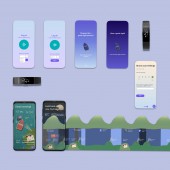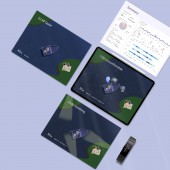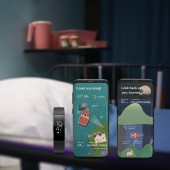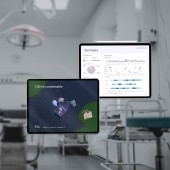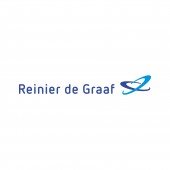Doplor Sleep Sleep Monitoring Mobile Application by Yiling Liu |
Home > Winners > #114626 |
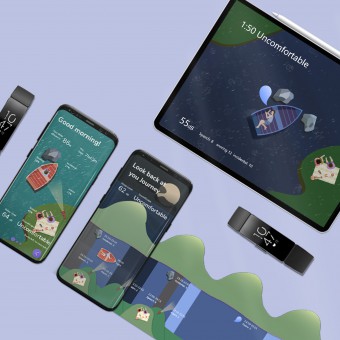 |
|
||||
| DESIGN DETAILS | |||||
| DESIGN NAME: Doplor Sleep PRIMARY FUNCTION: Sleep Monitoring Mobile Application INSPIRATION: Sleep deprivation caused by environmental factors can be fatal to critically ill patients. For example, various noises caused by false medical alarms, activities of hospital staff, conversations, etc. can cause delirium in patients with brain diseases. When it happens, patients are in a state of mental confusion and emotional disruption, which prolongs their hospital stay and, like a vicious circle, disturbs the rest of the other patients. A first-step solution can be creating awareness. UNIQUE PROPERTIES / PROJECT DESCRIPTION: Doplor Sleep is a bedtime monitoring application that provides insights into sound disturbances in the hospital. It captures the environmental sounds using the microphone of the smartphone, and the implemented algorithms directed classify the data recorded into different sound source categories, such as medical alarms, speech, incidental sounds, and snoring sounds. Doplor sleep is connected with the Fitbit sleep tracker and retrieves data from Fitbit API to form daily sleep-sound quality reports. As for the UI, we used friendly-looking illustrations to present the data and information, and a creative way of interaction to let users view the dynamic of their sleep status and the acoustical environment throughout the night. OPERATION / FLOW / INTERACTION: Before going to bed, the user presses the ship-icon button to start recording the environmental sounds. The next morning, the user presses the ship-icon again to stop recording. Then a sleep summary page occurs with information displayed such as sleep quality and sound quality. By Swiping to the left, the next screen occurs and the user sees more details about sees the presence of sounds (loudness levels and classifications) and sleep stages (wake, Light sleep, REM, and Deep sleep) during the whole by moving the boat forward along the river. Here we used boats as a time indicator and a representation of the sleeper, and the river indicating the timeline. The color blocks on the river represent the sleep stages. The icons of picnic, flashlight, rocks, and nose bubble indicate different sound classifications (speech, medical alarms, incidental sounds, and snores). Finally, by swiping to the left again, the user could fill in a short survey on their subjective feelings about sleep quality. The data will then be sent to the medical staff. PROJECT DURATION AND LOCATION: The project started in March 2020 and ends in October 2020 in Delft, the Netherlands. |
PRODUCTION / REALIZATION TECHNOLOGY: The whole system is built with the Android Studio IDE and used the Fitbit API for retrieving sleep data. SPECIFICATIONS / TECHNICAL PROPERTIES: The mobile application currently operates on Android devices, such as Android phones and devices. TAGS: Soundscape, Sleep, Sleep hygiene, Sleep quality, Hospital, sleep deprivation. RESEARCH ABSTRACT: Recently in the Netherlands, researchers have found that sleep duration and quality were suboptimal in the hospital. Evidence proved that many modifiable hospital-related factors negatively associated with patients' sleep (JAMA Internal Medicine, 2018). The sound factor is the most significant sleep disturbance in the hospital. In this graduation project, collaborating with Reiner de Graaf hospital and Critical Alarms lab, an information exchange the system was proposed to raise awareness of sound as sleep disturbance. The system captures the sound-producing events and visualizes them with visually attractive graphics. In this system, we use the smartphone as the sound captor. The recorded sounds are processed locally on the phone and converted into information such as sound level and the category it belongs to (alarm, speech, incidental sounds, or snore). Fitbit is implemented in the system to collect sleep information. To both patients and medical staff, The Doplor sleep system presents the influence of sound on sleep in a friendly and comprehensive way. During this project, a functioning prototype was developed. We have tested its functionality and user experience with the potential users. CHALLENGE: The first challenge is how to design a sound classification algorithm that could accurately classify the sounds of the hospital. The second one is to investigate how can we present the sound data and sleep data on the same timeline in a user-friendly way. ADDED DATE: 2020-12-20 18:03:49 TEAM MEMBERS (4) : Yiling Liu, Elif Özcan, Jered Vroon and Daan Kamphuis IMAGE CREDITS: Image #1: Illustrator Yiling Liu, Doplor Sleep Mockup, 2020. Image #2: Illustrator Yiling Liu, Doplor Sleep Phone Mockup, 2020. Image # 3: Illustrator Yiling Liu, Doplor Sleep Tablet Mockup, 2020. Image #4: Creator Yiling Liu, Doplor Sleep Phone Mockup, 2020. Image #5: Creator Yiling Liu, Doplor Sleep Phone Mockup, 2020. Video Credits: Creator Yiling Liu, Doplor Sleep Showcase, 2020 |
||||
| Visit the following page to learn more: https://www.yilingliustudio.com/doplor-s |
|||||
| AWARD DETAILS | |
 |
Doplor Sleep Sleep Monitoring Mobile Application by Yiling Liu is Winner in Mobile Technologies, Applications and Software Design Category, 2020 - 2021.· Read the interview with designer Yiling Liu for design Doplor Sleep here.· Press Members: Login or Register to request an exclusive interview with Yiling Liu. · Click here to register inorder to view the profile and other works by Yiling Liu. |
| SOCIAL |
| + Add to Likes / Favorites | Send to My Email | Comment | Testimonials | View Press-Release | Press Kit |
Did you like Yiling Liu's Mobile Design?
You will most likely enjoy other award winning mobile design as well.
Click here to view more Award Winning Mobile Design.


